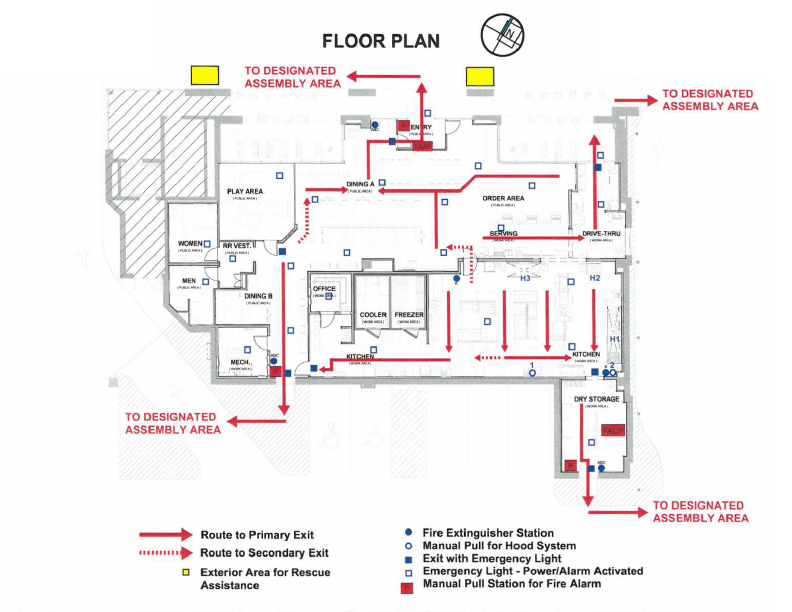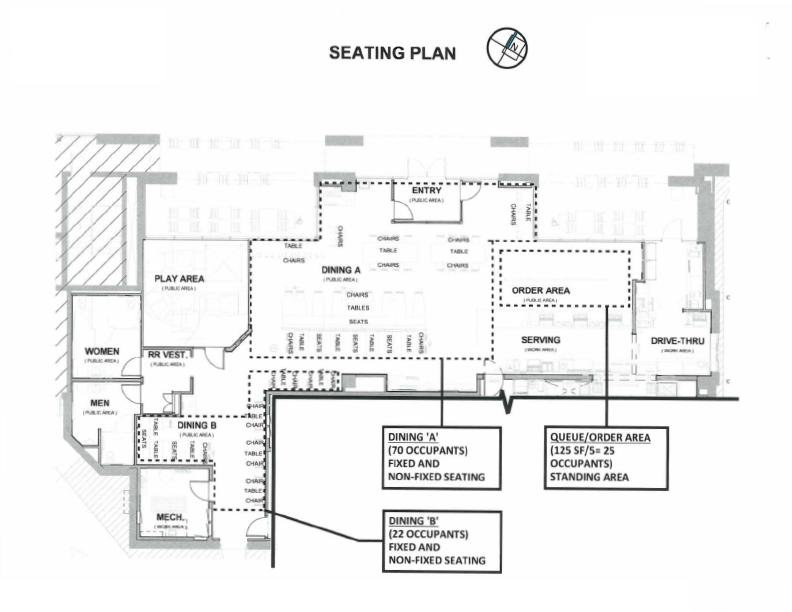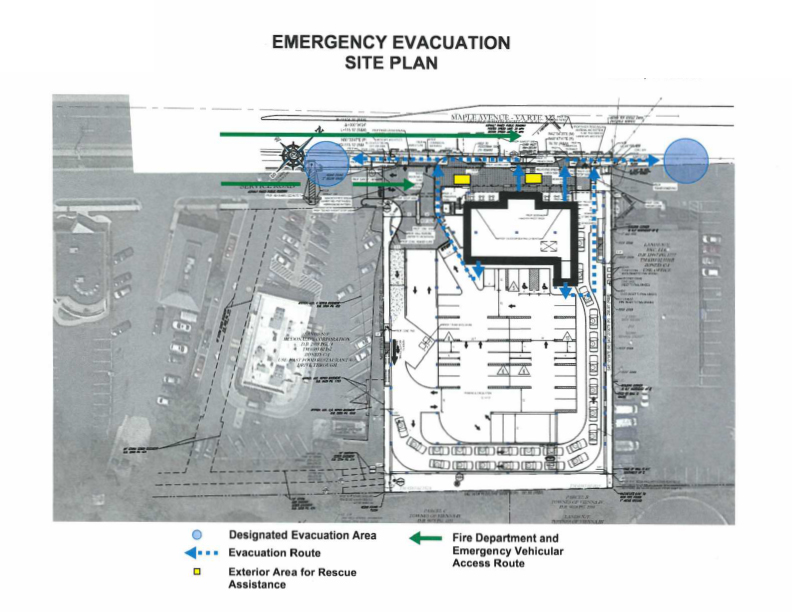In accordance with sections 401.2 and 404 of the Statewide Fire Prevention Code, a fire safety and evacuation plan shall be approved by the Fire Marshal, and maintained for the building types, facilities, and occupancies listed below. Please submit your Fire Safety & Evacuation Plans to the Fire Inspections Branch two weeks prior to your inspection. In addition, if the building, facility, or occupancy maintains a lockdown plan, Fire Marshal review and approval is also required. Read more about occupancies with Lockdown Plans online.
PLAN CREATION
Please consult Chapter 4 of the Statewide Fire Prevention Code for detailed information about the fire safety and evacuation planning requirements for each building, facility, or occupancy type. This plan guideline should provide most information needed for all occupancies.
Questions about emergency planning and preparedness may be directed to the Fire Prevention Inspections Section at 703-246-4849.
Samples cited in guideline:



MAINTENANCE & UPDATE OF PLAN
In accordance with Section 404.3 of the Fire Prevention Code, fire safety and evacuation plans shall be reviewed or updated annually or as necessitated by changes in staff assignments, occupancy, or the physical arrangement of the building.
The Fire Prevention Code requires employees and staff of business occupancies to be trained in the fire emergency procedures described in their approved fire safety and evacuation plans. Training shall be based on these plans. Employees shall receive training in the contents of fire safety and evacuation plans and their duties as part of new employee orientation and at least annually thereafter. Records shall be kept and made available to the fire marshal upon request.
- Fire Prevention Training. Employees/Staff shall be apprised of the fire hazards of the materials and processes to which they are exposed. Each employee shall be instructed in the proper procedures for preventing fires in the conduct of their assigned duties.
- Evacuation Training. Employees/Staff shall be familiarized with the fire alarm and evacuation signals, their assigned duties in the event of an alarm or emergency, evacuation routes, areas of refuge, exterior assembly areas, and procedures for evacuation.
- Fire Safety Training. Employees/Staff assigned fire-fighting duties shall be trained to know the locations and proper use of portable fire extinguishers or other manual fire-fighting equipment and the protective clothing or equipment required for its safe and proper use.
In accordance with sections 401.3 of the Fire Prevention Code, notification of emergency responders shall be as follows:
- Fire Events. In the event an unwanted fire occurs on a property, the owner or occupant shall immediately notify the fire to the fire department (911) and implement the evacuation plan.
- Alarm Activations. Upon activation of a fire alarm signal, employees or staff shall immediately notify the fire department (911) and implement the evacuation plan.
- Hazardous Materials Release. Any person who witnesses, discovers, or otherwise has knowledge of a spill, leak or other release of a hazardous material or other material that may negatively impact the environment, regardless of quantity, shall immediately report such spill, leak or release to the Department of Public Safety Communications (911).
- Delayed Notification. A person shall not, by verbal or written directive, require any delay in the reporting of a fire to the fire department.
- False Report. It shall be unlawful for a person to give, signal, or transmit a false alarm.
- Interference with F.D. Operations. It shall be unlawful to interfere with, attempt to interfere with, conspire to interfere with, obstruct or restrict the mobility of or block the path of travel of a fire department emergency vehicle in any way, or to interfere with, attempt to interfere with, conspire to interfere with, obstruct or hamper any fire department operation.
In accordance with Section 405 of the Fire Prevention Code, emergency evacuation drills complying with the provisions listed below shall be conducted at least annually or when required by the fire code official. Drills shall be designed in cooperation with the local authorities.
- Purpose. Emergency evacuation drills shall be held to familiarize occupants, employees, and staff with the evacuation procedure.
- Leadership. Responsibility for planning and conducting the drills shall be assigned to a competent person(s) designated to exercise leadership.
- Time. Drills shall be held at unexpected times and under varying conditions to simulate the unusual conditions that occur in case of fire.
- Records. Records of required emergency evacuation drills shall be maintained and include:
- Identity of the person conducting the drill, date, and time of the drill
- Notification method used and staff members on duty and participating
- Number of occupants evacuated
- Special conditions simulated
- Problems encountered
- Weather conditions when occupants were evacuated
- Time required to accomplish complete evacuation
- Notification. Prior notification of the emergency evacuation drill is required. Notification shall be made by calling Department of Public Safety Communications (DPSC) at the non-emergency number 703-691-2131.
- Initiation of Evacuation. Where a fire alarm system is provided, emergency evacuation drills shall be initiated by activating the fire alarm system.
- Accountability. As building occupants arrive at the assembly point, efforts shall be made to determine if all occupants have been successfully evacuated or have been accounted for.
- Recall & Reentry. An electrically or mechanically operated signal used to recall occupants after an evacuation shall be separate and distinct from the signal used to initiate the evacuation. The recall signal initiation means shall be manually operated and under the control of the person in charge of the premises or the official in charge of the incident. No one shall reenter the premises until authorized to do so by the official in charge.
- Unplanned Evacuations Not a Substitute for Required Drills. Evacuations made necessary by the unplanned activation of a fire alarm system or by any other emergency shall not be substituted for a required drill.
In accordance with Section 405.2 of the Fire Prevention Code, required emergency evacuation drills shall be held at the intervals specified in the table below, or more frequently, where necessary to familiarize all employees and/or occupants with the evacuation procedure.
| Occupancy Type | Frequency | Participation |
|---|---|---|
| Group A - Assembly | Quarterly | Employees |
| Group Bb | Annually | All occupants |
| Group Bb,c (Ambulatory Care Facilities) | Annually | Employees |
| Group Bb (Clinic, outpatient) | Annually | Employees |
| Group E | Monthlya | All occupants |
| Group F | Annually | Employees |
| Group I-1 | Semiannually on each shifta | All occupants |
| Group I-2 | Quarterly on each shifta | Employees |
| Group I-3 | Quarterly on each shifta | Employees |
| Group I-4 | Monthly on each shifta | All occupants |
| Group R-1 | Quarterly on each shifta | Employees |
| Group R-2d | Four annually | All occupants |
| Group R-4 | Semiannually on each shifta | All occupants |
| State Regulated Care Facilities | Monthly | All occupants |
*Business occupancies having an occupant load of 500 or more persons for the entire occupancy or 100 more persons for areas of the occupancy located above or below the lowest level of exit discharge
In accordance with Section 901.7 of the Fire Prevention Code (as amended by Fairfax County), where a fire protection system is out of service, the fire department and the fire code official shall be notified immediately by calling the Office of the Fire Marshal at 703-246-4821 during regular office hours. Otherwise, notification shall be made by calling Department of Public Safety Communications (DPSC) at the non-emergency number 703-691-2131.
The Fire Prevention Code requires the following with respect to hazardous materials:
- MSDS. Material Safety Data Sheets (MSDS) for all hazardous materials requiring a Fire Prevention Code Permit (FPCP) from the Office of the Fire Marshal shall be readily available on the premises as a paper copy, or where approved by the fire marshal, shall be permitted to be readily retrievable by electronic access.
- Labeling. Individual containers of hazardous materials, cartons or packages shall be marked or labeled in accordance with applicable federal regulations. Buildings, rooms and spaces containing hazardous materials shall be identified by hazard warning signs.
- Liaison Personnel. Persons responsible for the operation of areas in which hazardous materials are stored, dispensed, handled or used shall be familiar with the chemical nature of the materials and the appropriate mitigating actions necessary in the event of a fire, leak or spill. Responsible persons shall be designated and trained to be liaison personnel for the fire department. These persons shall aid the fire department in preplanning emergency responses and identification of the locations where hazardous materials are located and shall have access to Material Safety Data Sheets and be knowledgeable in the site emergency response procedures. Liaison personnel should be identified in the written plan.
In accordance with Section 403.2 of the Fire Prevention Code, assembly occupancies shall comply with the following code provisions in addition to the general requirements for emergency planning and preparedness.
- Exit Identification Announcements. In accordance with Section 403.2.2 of the Fire Prevention Code, in theaters, motion picture theaters, auditoriums and similar assembly occupancies in Group A used for non-continuous programs, an audible announcement shall be made not more than 10 minutes prior to the start of each program to notify the occupants of the location of the exits to be used in the event of a fire or other emergency. Exception: In motion picture theaters, the announcement is allowed to be projected upon the screen in a manner approved by the fire code official.
- Audible Announcements in Night Clubs. In accordance with Section 403.2.2.1.1 of the Fire Prevention Code, audible announcements shall be made to the occupants no longer than 10 minutes prior to the start of the entertainment and at each intermission to notify the occupants of the location of the exits to be used in the event of a fire or other emergency.
- Occupant Load Count in Night Clubs. In accordance with Section 403.2.2.1.2 of the Fire Prevention Code, upon request of the fire code official, the owner or operator, or both, will be required to keep a running count of the occupant load to provide to the fire code official during performance hours of operation, entertainment hours of operation, or both.
Where facilities develop a lockdown plan requiring that occupants be sheltered and secured in place within a building or occupancy when normal evacuation would put occupants at risk, the lockdown plan shall be reviewed and approved by the Office of the Fire Marshal. Detailed information is available online for lockdown planning requirements and approval procedures.
To obtain more information which may assist you in developing a fire safety and evacuation plan, or to enhance occupant safety in occupancies, copy and paste any of the following web addresses into your browser, or simply search the Internet for these topics.
Every Business Should Have an Evacuation Plan
How to Create an Emergency Evacuation Map

